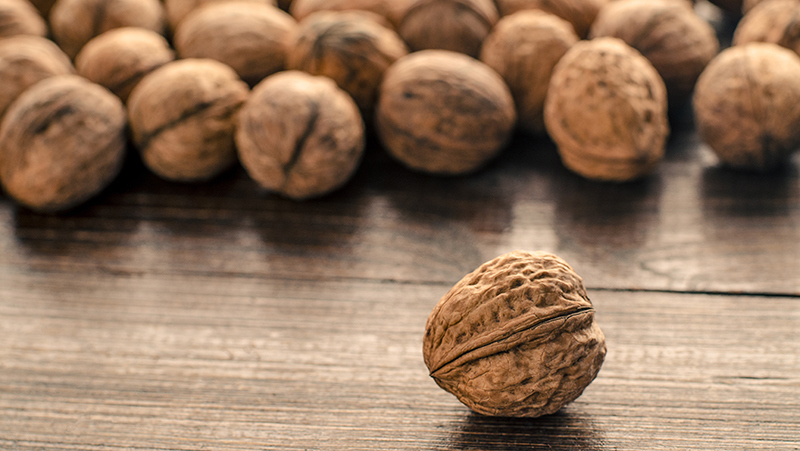Yates Account
Join now
Create a Yates account today!
Sign up to join the Yates Garden Club for monthly e-mails packed with seasonal inspiration, tips for success & exclusive promotions.
Plus if you’re a Garden Club member you can take part in the Yates Growing Community - a blog to share successes, get advice & win prizes in fun challenges along the way!

Forgot password
Enter the email address associated with your account, and we'll email you a new password.

They say you can’t judge a book by its cover and thank goodness for that! Otherwise, we may have never tasted the delicious nutty flavours of the classic walnut. It’s one of the oldest tree foods known to man – dating back to 7000BC – and incredibly nutritious, too. You do need serious room for this tree though as it can reach dizzying heights of 15m or taller. Plus, at least two trees are recommended to help with pollination – so consider your space before planting!
How to grow Walnuts in a garden
- Choose a sunny spot with well drained soil. Enrich the soil with Yates Dynamic Lifter Organic Plant Food and Yates Natures Way Organic Compost & Soil Improver. If the soil is clay based, improve soil structure by adding gypsum and forking in well.
- Dig the planting hole twice as wide and to the same depth as the root-ball. Remove the plant from the container, gently tease the roots and cut away any circled or tangled roots.
- Position in hole and backfill with soil, gently firming down. Form a raised doughnut shaped ring of soil around the outer edge of the plant's root zone. This helps keep water where it's needed. Always water in well after planting to settle the soil around the roots and keep the soil moist for several weeks while the new plant establishes.
- Mulch around the base with organic mulch like woodchip or pea straw, keeping it away from the trunk.
- Water deeply, once or twice a week, depending on weather conditions.
- During the growing and flowering/fruiting season, feed with Yates Thrive Citrus & Fruit Granular Plant Food. TIP: for an added boost during the flowering/fruiting season, apply Yates Thrive Natural Fish & Seaweed+ Plant Food Concentrate.
- Reapply Yates Dynamic Lifter Organic Plant Food and Yates Natures Way Organic Compost & Soil Improver at least once or twice a year to keep the soil nice and rich.

Growing tips
- Two varieties are desirable for effective cross-pollination.
- Walnuts grow into very large trees that are ideal for country estates in cool, reasonably moist climates. Their ultimate size makes them too large for most suburban gardens.
- Most familiar variety is the 'English' or 'Persian' walnut.
- While modern varieties of walnut bear fruit within their first few years, it takes 4–6 years to produce a harvestable quantity and 10–12 years for the tree to reach full production.
- Pruning is required every 3–4years depending on growth rates of the tree.
More Plants
Feijoa trees are a familiar sight in kiwi gardens; they're also a great choice for an edible hedge. The delicious fruit can be eaten fresh; they’re also perfect for using in cakes, muffins, jams, cocktails, desserts, fruit salad and smoothies.
Currants
Tart and sweet, blackcurrant and redcurrant fruit have a short summer season, so grab them while you can.
Strawberry
Strawberries happily grow in raised garden beds, in the garden, in pots or even hanging baskets. Eat them fresh, cooked or make into jams.
Apples
Apples can grow into large trees, but you can also find dwarf forms. Be sure to find a self-fertile variety or two which can cross-pollinate.
Yates Thrive Citrus & Fruit Granular Plant Food
Fast acting, gradual feeding plant food specially formulated to grow citrus & fruit trees, with high potassium for more abundant fruit & added magnesium to help prevent leaf yellowing.
Yates Thrive Natural Fish & Seaweed+ Plant Food Concentrate
A complete plant food enriched with natural fish, seaweed, humates, molasses and more - boosted with NPK to improve plant and soil vitality.
Yates Dynamic Lifter Organic Plant Food
Releases nutrients slowly, improves the structure and moisture retention of the soil and encourages earthworms and beneficial soil micro-organisms.
Yates Nature's Way Organic Compost & Soil Improver
Transform soil into a healthy nutrient-rich base for your gardens and lawns with Yates Nature’s Way Organic Compost & Soil Improver.
















Share
Share this article on social media